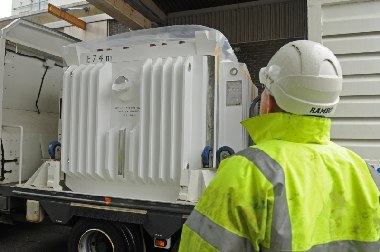Defuelling operations have been completed at two of the UK's oldest nuclear power plant sites. Meanwhile, one of the most hazardous legacies from the country's early nuclear research has been destroyed in an operation that has exceeded expectations.
 |
| The final fuel flask leaves Dungeness A (Image: Magnox) |
A five-year defuelling operation has been completed at the Dungeness A nuclear power plant with the shipment of the final flask of used fuel to Sellafield in Cumbria. The defuelling operation has removed 99% of the radiation hazard from the site, where two 225 MWe Magnox reactors operated from 1965 to 2006.
Dungeness A site director Ray Jepps explained that over the last year his team had been shipping up to four flasks of fuel per week from the site. "We must now complete a program of work to demonstrate that all the fuel has gone before we can formally notify our regulators, the Office for Nuclear Regulation and the Environment Agency. Once they accept our notification the site will be re-categorised, decreasing our security and nuclear emergency preparedness requirements, and allowing us to move into the next stage of decommissioning," he said.
Meanwhile, another Magnox site is making its own defuelling progress. Chapelcross in Scotland was one of the world's earliest nuclear power plants, with four 49 MWe units operating from 1959 and 1960 until 2004. Unit 3 has now become the first Chapelcross unit to be fully defuelled, with the removal of all of its 9245 fuel elements. Defuelling is also expected to be completed at reactor 4 within weeks.
To date, 23,203 elements representing 61% of the fuel at the Chapelcross site have been shipped to Sellafield since regulatory permission to begin defuelling was granted in 2008. The defuelling program for the site remains on course for completion by June 2013.
A fleet of 26 Magnox reactors came into operation in the UK between 1956 and 1971 starting with Calder Hall, the world's first commercial nuclear power station. The two youngest Magnox reactors remain in operation at Wylfa, although one of those is scheduled for closure on 30 April.
Dounreay destroys last of coolant
Some 57,000 litres of liquid metal coolant from an experimental fast breeder reactor, described as a major chemical and radiological hazard, has been transformed into 20,000 tonnes of salty water in a purpose-built facility at Dounreay in Scotland.
The Dounreay Fast Reactor operated from 1959 to 1977, and in 1962 became the first fast reactor in the world to supply power to the grid. It was cooled by a liquid alloy of sodium and potassium in two cooling circuits connected by heat exchangers. Over 100,000 litres of coolant from the secondary circuit was destroyed when the reactor shut down, but the coolant in the primary circuit proved harder to address: its direct contact with the fuel in the reactor core had contaminated it with radioactive caesium.
As well as high levels of radioactive contamination the liquid alkali metal presents a chemical hazard, reacting when it comes into contact with air or water. These problems brought work on the primary circuit to a halt in the mid-1980s until a solution could be found. This solution was a purpose-built plant to chemically neutralise the alkali metal to a salty water before extracting the caesium via ion exchange.
The treatment plant, which started up in 2007, had been designed to decontaminate the effluent by a factor of 1000 but proved to be even more effective at its task than its designers had envisaged. Decontamination rates of up to 4 million times were achieved during operation, reducing radiation levels in effluent below detection limits. The resin columns used to trap the caesium will now be cemented up and managed as higher-activity waste.
Andy Swan, engineer in charge of reactor decommissioning, praised his team for delivering the milestone ahead of schedule and to higher environmental standards than thought possible at the design stage. "This stuff was highly volatile and highly radioactive," he added, noting the chemical and radiological hazards involved and the excellent safety record throughout the operation.
Destruction of the liquid metal was a strategic national priority for the UK's Department of Energy and Climate Change, which sponsors the Nuclear Decommissioning Authority. Now the reactor vessel is empty of liquid metal, attention is turning to cleansing residual traces from the primary circuit pipework and destroying small pockets in other vessels.
Researched and written
by World Nuclear News




_47120.jpg)

_23621.jpg)






